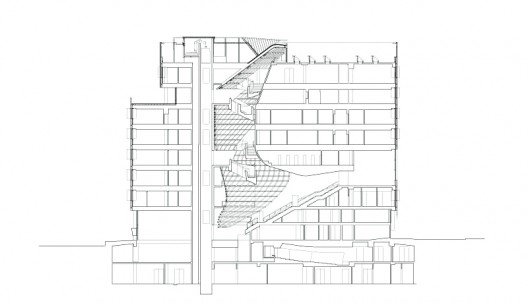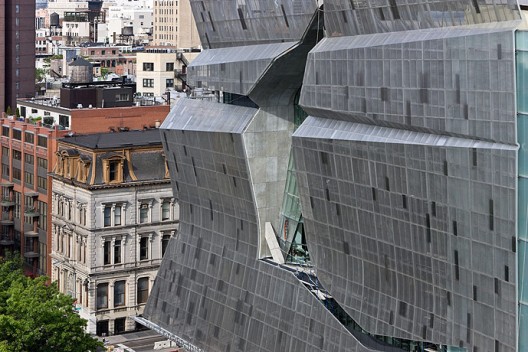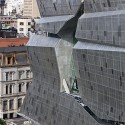The Cooper Union for the Advancement of Science and Art / Morphosis Architects

Architecture: Morphosis Architects
Thom Mayne, Principal / Design Director
Silvia Kuhle, Project Manager
Pavel Getov, Project Architect
Jean Oei, Job Captain/ Project Designer
Chandler Ahrens / Lead Designer
Project Designers: Natalia Traverso Caruana, Go-Woon Seo
Project Team: Irena Bedenikovic, Salvador Hidalgo, Debbie Lin, Kristina Loock,
IT Co-ordinator: Marty Doscher
Project Assistants: Ben Damron, Graham Ferrier
Model Team: Reinhard Schmoelzer with Patrick Dunn-Baker, Charles Austin, Sean Anderson, Domenique Cheng, Soohyun Cheng, Eui Yeob Jeong, Amy Kwok, Shannon Loew, Brock Hinze, Hugo Martinez, Greg Neudorf
Associated Architect: Gruzen Samton
Owner’s Representative: Jonathan Rose Companies
General Contractor: FJ Sciame
Client: The Cooper Union for the Advancement of Science and Art
Program: Academic and laboratory building with exhibition gallery, auditorium, lounge and multi-purpose space, and retail space
Constructed Area: 16,258 sqm
Design Year: 2004-2006
Construction Year: 2006-2009
Photographs: Iwan Baan




41 Cooper Square, the new academic building for The Cooper Union, aspires to manifest the character, culture and vibrancy of both the 150 year-old institution and of the city in which it was founded. The institution remains committed to Peter Cooper’s radically optimistic intention to provide an education “as free as water and air” and has subsequently grown to become a renowned intellectual and cultural center for the City of New York. 41 Cooper Square aspires to reflect the institution’s stated goal to create an iconic building – one that reflects its values and aspirations as a center for advanced and innovative education in Art, Architecture and Engineering.

From the double-high entry lobby, the grand stair ascends four stories to terminate in a glazed double-high student lounge overlooking the city. On the fifth through ninth floors, sky lobbies and meeting places—including a student lounge, seminar rooms, lockers, and seating areas overlooking the cityscape—are organized around the central atrium. Sky bridges span the atrium to create connections between these informal spaces. Further reinforcement of the strategy to create a vibrant intellectual space is provided by the “skip-stop” circulation strategy which allows for both increased physical activity and for more impromptu meeting opportunities. The primary skip-stop elevators, which make stops at the first, fifth and eighth floors, encourage occupants to use the grand stairs and sky bridges. Secondary elevators stop at each floor, both for ADA compliance and for the practical tasks of moving materials, artworks, and equipment.

The building reverberates with light, shadow and transparency via a high performance exterior double skin whose semi-transparent layer of perforated stainless steel wraps the building’s glazed envelope to provide critical interior environmental control, while also allowing for transparencies to reveal the creative activity occurring within. Responding to its urban context, the sculpted facade establishes a distinctive identity for Cooper Square. The building’s corner entry lifts up to draw people into the lobby in a deferential gesture towards the institution’s historic Foundation Building. The façade registers the iconic, curving profile of the central atrium as a glazed figure that appears to be carved out of the Third Avenue façade, connecting the creative and social heart of the building to the street.


- An operable building skin made of perforated stainless steel panels offset from a glass and aluminum window wall. The panels reduce the impact of heat radiation during the summer and insulate interior spaces during the winter.
- Radiant heating and cooling ceiling panels introduce innovative HVAC technology that will boost energy efficiency. This contributes to making the new building 40 percent more energy efficient than a standard building of its type.
- A full-height atrium enables unique circulation for building occupants, improves the flow of air and provides increased interior day lighting.
- Seventy-five percent of the building’s regularly occupied spaces are lit by natural daylight.
- A green roof insulates the building, reduces city “heat island” effect, storm water runoff and pollutants; harvested water is reused.
- A cogeneration plant provides additional power to the building, recovers waste heat and effectively cuts energy costs.
- Flexible state-of-the-art laboratories, studios and classrooms are specifically designed to accommodate pedagogical objectives, as well as current and future research activities.
- © Iwan Baan
- © Iwan Baan
- © Iwan Baan
- © Iwan Baan
- © Iwan Baan
- © Iwan Baan
- © Iwan Baan
- © Iwan Baan
- © Iwan Baan
- © Iwan Baan
- location diagram
- basement 01 plan
- basement 02 plan
- level 01 floor plan
- level 02 floor plan
- level 03 floor plan
- level 04 floor plan
- level 05 floor plan
- level 06 floor plan
- level 07 floor plan
- level 08 floor plan
- level 09 floor plan
- north & west elevations
- south & east elevations
- section A
- section B
- atrium geometry diagram
- circulation diagram
- façade geometry diagram
- program & sustainable strategies diagram
- rotated atrium diagram
- skip stop stair diagram
- sketch
- sketch
- model
- model
- model
- model


































No comments:
Post a Comment
Please leave a comment-- or suggestions, particularly of topics and places you'd like to see covered